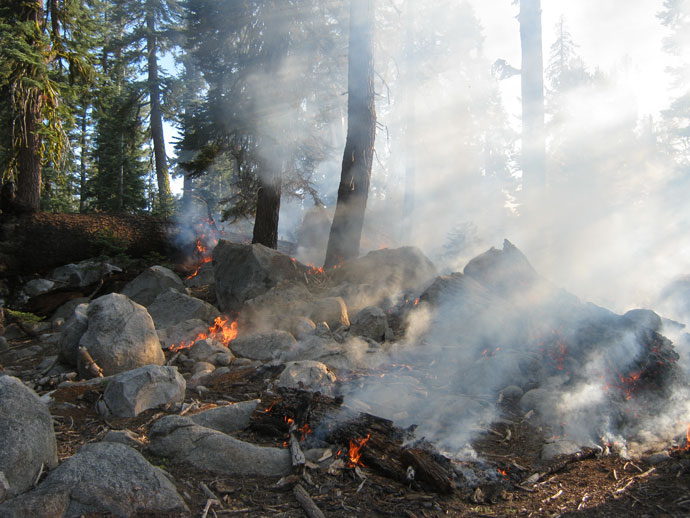It is burning in a short needle red fir forest between two upper forks of the Cascade Creek. It continues to creep and smolder, through fingers and layers of surface fuels and brush. The fire moves stick to stick and log to log, with low intensity, 6 to 12 inch flame lengths, and smolders through ground fuels of duff and forest litter. It occasionally creates enough heat to ignite brush. Isolated single tree torching was observed by Yosemite fire monitors. As the fire has moved the area it leaves standing live trees with pockets and mosaics of unburned forest. The growth rate and fire behavior is not expected to change as the fire moves to the north. Firefighters continue to monitor and scout the fire weekly.
This lightning caused fire has been slowly burning since June 16, in Yosemite's high elevation Wilderness. It started during an afternoon thunderstorm on June 15th. The wilderness fire poses no threat to trails, buildings, infrastructure or roads, cultural or natural resources. Fire Managers and the park Superintendent evaluate daily the spread, growth and impacts of the fire. The Cascade Fire meets the park fire management objectives of minimal risk to firefighter and public safety, federal and public property, air quality and Wilderness character.
The fire could potentially grow to 1000 acres. Although the immediate fire area has a history of lightning, there is no recorded recent large fire history. The nearest historic fire to the Cascade Fire suggests that fires at this elevation, in this forest type, creep and smolder for weeks and only make runs during dry windy conditions. Fire in red fir forests occur about once in every 30 years.
Light smoke has been visible in the morning hours near Cascade Falls and the community of Foresta. Smoke has become more visible at higher elevations within the park and along the Tioga Rd near Yosemite Creek and Glacier Point Rd. Fire managers are working closely with state and local air pollution regulators concerning potential adverse air quality impacts to nearby smoke sensitive areas. Yosemite's Division of Resources Management and Sciences personnel have installed air quality monitoring equipment within the communities of Lee Vining, Yosemite West, El Portal, Foresta and Yosemite Valley. Tuolumne County APCD has installed a smoke monitor at Pine Mountain Lake Airport. The park's webcam located at Crane Flat Helibase will capture fire images, which can be viewed at: https://ssgic.cr.usgs.gov/dashboards/WebCam.htm

